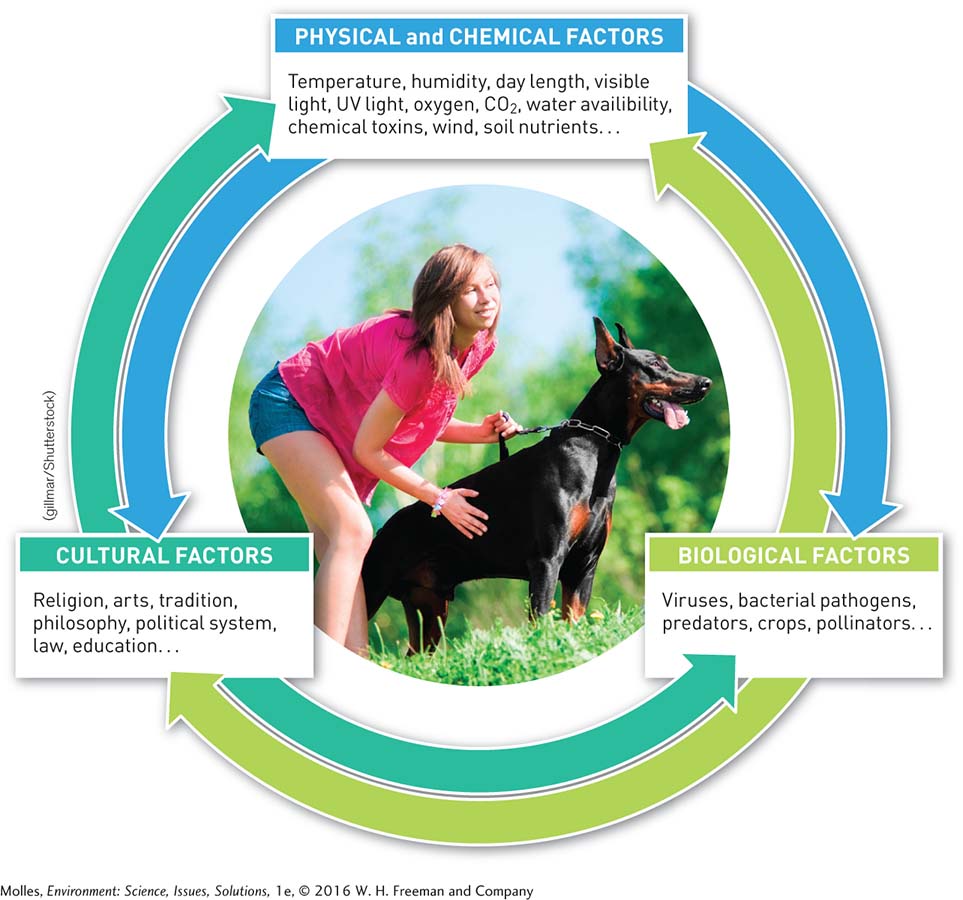1.1–1.4 Science


Is food a chemical factor in the environment, a biological factor, or both? What does your answer imply about the classification of environmental factors?
Because of our origins as hunters and subsistence farmers, humans have long been interested in the relationship between organisms and their environment. Even, today, with a larger fraction of the world’s population living in cities and working in jobs as diverse as driving a taxi or programming computer software, we recognize that our impact on the environment extends to the entire planet and those historical interests assume a new urgency. But just what is “environment”?
1.1 Environment is everything
environment The physical, chemical, and biological conditions that affect an organism.
biotic Living components of the environment.
abiotic Physical and chemical components of the environment.
The environment consists of both the biotic and abiotic factors that affect an organism. Biotic factors are the living components of the environment. Abiotic factors include the physical and chemical components of the environment. In environments where humans have significant influences, we must also consider cultural components (Figure 1.1).

Think of the “feel” of a misty morning compared to the direct rays of the summer Sun. That’s your physical, abiotic environment, which includes factors such as temperature, humidity, and cloud cover, which affects the intensity of sunlight. The physical environment also includes factors that play themselves out over time, such as seasonal changes in temperature or day length. It also includes noise, such as the cock-
Furthermore, abiotic factors include the chemicals found in the environment. When you drink a glass of water, with its dissolved oxygen, minerals, and pollutants, you are ingesting a piece of the chemical environment. The chemical environment includes the composition of air, water, and soil. The number, kinds, and concentrations of pollutants the air may contain, as well as the odors in your surroundings, are part of your chemical environment, as are the nutrients in the food you eat (Figure 1.2). A plant’s chemical environment includes all the nutrients in the soil or surrounding water, as well as the gases in the surrounding air and soil.

Chemical and physical factors are often closely intertwined, and these relationships are at the center of many of today’s environmental problems. For example, scientists discovered that when we released refrigerant chemicals known as chlorofluorocarbons (CFCs) into the environment, we thinned stratospheric ozone. This, in turn, changed the physical environment at the Earth’s surface by permitting more UV light to pass through the atmosphere. Conversely, altering a physical factor can change important aspects of the chemical environment. For instance, increasing the temperature of a pond will reduce the concentration of oxygen that the pond water can hold. Chemical and physical factors have direct and indirect influences on the biological environment.
biological environment The kinds and diversity of pathogens, predators, parasites, and competitors with which an organism interacts.
A scientific study of the New York City subway system that began in 2013 mapped out species of bacteria found on everything from the turnstiles to the benches to the garbage cans. Pathomap, as the study is called, is a partial record of the biological environment faced by commuters each and every day. More generally, your biological environment will include all the viral or bacterial diseases you’ve contracted during your life and the frequency with which you are exposed to new pathogens, plants, and animals (Figure 1.3). The biological communities inhabiting the waters and lands from which that food is extracted, the insects that pollinate crop plants, and the microorganisms that help sustain the fertility of soils represent an extended biological environment. We respond to our biological environment as we choose to eat particular foods and avoid others, when we wash our hands, or attempt to control the insects that intrude into our lives.


Are all environmental problems facing humans ultimately cultural?
Culture makes human interaction with the environment even more complex than that of other species. Cultural factors such as religion, philosophy, and the educational system influence how we view and interact with the environment. Culture affects everything from how we view wild and domestic species and the way we dispose of trash to our attitude toward birth control. The economic and political systems and the laws of the community and nation where we reside can have major effects on how environmental questions are addressed, how the environment is managed, and how citizens view environmental regulation. On a more personal scale, our cultural environment affects how many and with which people we come into contact on a daily basis and the types of interactions we have or do not have with those individuals.
Think About It
In developed countries, it is often said that we are insulated from the physical and biological forces of nature. Do you think this statement is true? Why or why not?
How does ozone thinning demonstrate the interaction of physical, chemical, and cultural aspects of the environment?